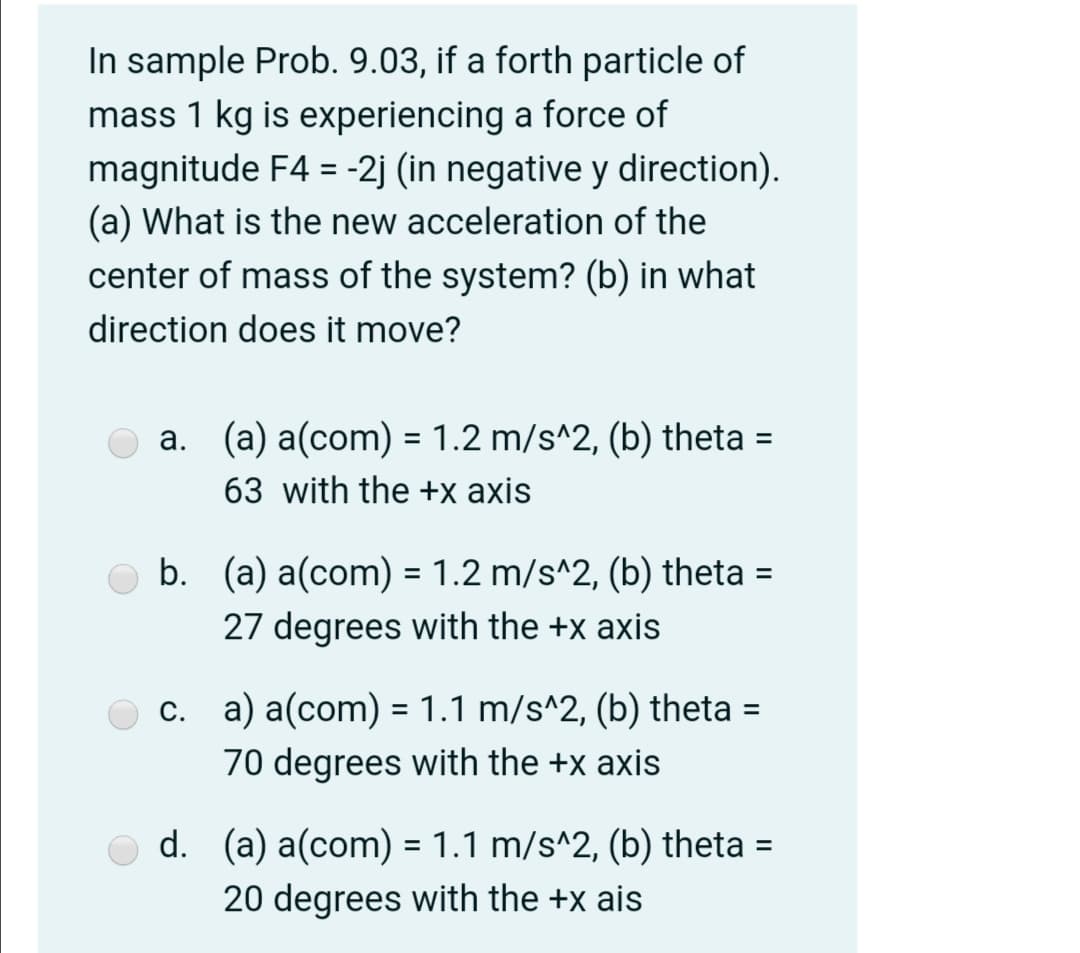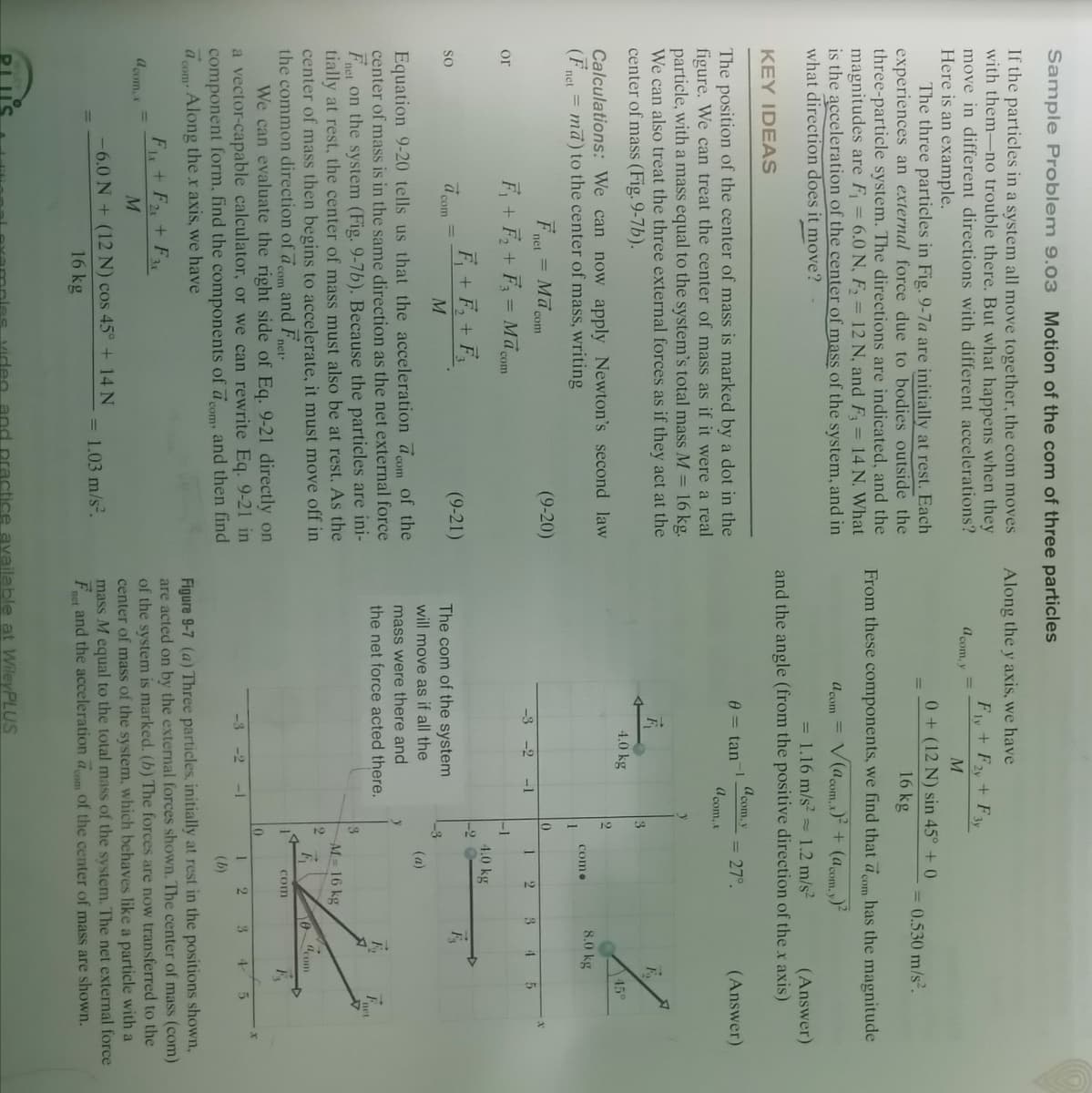In sample Prob. 9.03, if a forth particle of mass 1 kg is experiencing a force of magnitude F4 = -2j (in negative y direction). (a) What is the new acceleration of the center of mass of the system? (b) in what direction does it move? a. (a) a(com) = 1.2 m/s^2, (b) theta = 63 with the +x axis b. (a) a(com) = 1.2 m/s^2, (b) theta = 27 degrees with the +x axis c. a) a(com) = 1.1 m/s^2, (b) theta = 70 degrees with the +x axis d. (a) a(com) = 1.1 m/s^2, (b) theta 20 degrees with the +x ais
In sample Prob. 9.03, if a forth particle of mass 1 kg is experiencing a force of magnitude F4 = -2j (in negative y direction). (a) What is the new acceleration of the center of mass of the system? (b) in what direction does it move? a. (a) a(com) = 1.2 m/s^2, (b) theta = 63 with the +x axis b. (a) a(com) = 1.2 m/s^2, (b) theta = 27 degrees with the +x axis c. a) a(com) = 1.1 m/s^2, (b) theta = 70 degrees with the +x axis d. (a) a(com) = 1.1 m/s^2, (b) theta 20 degrees with the +x ais
Classical Dynamics of Particles and Systems
5th Edition
ISBN:9780534408961
Author:Stephen T. Thornton, Jerry B. Marion
Publisher:Stephen T. Thornton, Jerry B. Marion
Chapter11: Dynamics Of Rigid Bodies
Section: Chapter Questions
Problem 11.31P
Related questions
Question

Transcribed Image Text:In sample Prob. 9.03, if a forth particle of
mass 1 kg is experiencing a force of
magnitude F4 = -2j (in negative y direction).
(a) What is the new acceleration of the
center of mass of the system? (b) in what
direction does it move?
O a. (a) a(com) = 1.2 m/s^2, (b) theta =
%3D
63 with the +x axis
b. (a) a(com) = 1.2 m/s^2, (b) theta =
27 degrees with the +x axis
%3D
c. a) a(com) = 1.1 m/s^2, (b) theta
%D
70 degrees with the +x axis
d. (a) a(com) = 1.1 m/s^2, (b) theta
%3D
20 degrees with the +x ais

Transcribed Image Text:Sample Problem 9.03 Motion of the com of three particles
If the particles in a system all move together, the com moves
with them-no trouble there. But what happens when they
move in different directions with different accelerations?
Here is an example.
The three particles in Fig. 9-7a are initially at rest. Each
experiences an external force due to bodies outside the
three-particle system. The directions are indicated, and the
magnitudes are F = 6.0 N, F, = 12 N, and F = 14 N. What
is the acceleration of the center of mass of the system, and in
what direction does it move?
Along the y axis, we have
Fy + F + F
a com, y
0 + (12 N) sin 45° + 0
0.530 m/s.
16 kg
From these components, we find that acom has the magnitude
a com
V(a com.) + (acom.y)
= 1.16 m/s? 1.2 m/s
and the angle (from the positive direction of the x axis)
(Answer)
KEY IDEAS
A com.y
-1
0 = tan
= 27°.
(Answer)
The position of the center of mass is marked by a dot in the
figure. We can treat the center of mass as if it were a real
particle, with a mass equal to the system's total mass M = 16 kg.
We can also treat the three external forces as if they act at the
center of mass (Fig. 9-7b).
a com, x
4.0 kg
45°
Calculations: We can now apply Newton's second law
8.0 kg
(Fnet = md) to the center of mass, writing
como
Fnet= Mac
(9-20)
com
-3
-2
-1
2
4
F+ F, + F, = Ma com
or
-1
F+ F, + F
4.0 kg
-2
d com
(9-21)
so
The com of the system
3
will move as if all the
(a)
Equation 9-20 tells us that the acceleration dcom of the
center of mass is in the same direction as the net external force
mass were there and
the net force acted there.
Inet
Fnet on the system (Fig. 9-7b). Because the particles are ini-
tially at rest, the center of mass must also be at rest. As the
center of mass then begins to accelerate, it must move off in
the common direction of a
We can evaluate the right side of Eq. 9-21 directly on
a vector-capable calculator, or we can rewrite Eq. 9-21 in
component form, find the components of aom, and then find
a
M= 16 kg
e "com
and F-
net
com
com
F.
10
-3 -2
-1
2.
3.
4
(b)
Along the x axis, we have
Figure 9-7 (a) Three particles, initially at rest in the positions shown,
are acted on by the external forces shown. The center of mass (com)
of the system is marked. (b) The forces are now transferred to the
center of mass of the system, which behaves like a particle with a
mass M equal to the total mass of the system. The net external force
F and the acceleration aom of the center of mass are shown.
com
F, + F + F
a com, x
-6.0 N + (12 N) cos 45° + 14 N
= 1.03 m/s2.
16 kg
net
ractice available at WileyPLUS
Expert Solution
This question has been solved!
Explore an expertly crafted, step-by-step solution for a thorough understanding of key concepts.
Step by step
Solved in 3 steps

Knowledge Booster
Learn more about
Need a deep-dive on the concept behind this application? Look no further. Learn more about this topic, physics and related others by exploring similar questions and additional content below.Recommended textbooks for you

Classical Dynamics of Particles and Systems
Physics
ISBN:
9780534408961
Author:
Stephen T. Thornton, Jerry B. Marion
Publisher:
Cengage Learning

University Physics Volume 3
Physics
ISBN:
9781938168185
Author:
William Moebs, Jeff Sanny
Publisher:
OpenStax

Classical Dynamics of Particles and Systems
Physics
ISBN:
9780534408961
Author:
Stephen T. Thornton, Jerry B. Marion
Publisher:
Cengage Learning

University Physics Volume 3
Physics
ISBN:
9781938168185
Author:
William Moebs, Jeff Sanny
Publisher:
OpenStax